Making a fruit bouquet — a great way to show care, express sympathy or make an original gift. However, it is not as easy to pack it, compared to flowers or candies. Since fruits are delicate, they ripen and spoil, so it is important to assemble compositions from them with extreme care.
Necessary materials and tools
A fruit bouquet is beautiful and delicious, but to get the best results you will need a wide range of colors, shapes, and sizes. Also, if you don’t know exactly what kind of fruit the recipient prefers, it’s a good idea to use as many varieties as possible.
In addition to fruits, you will also need practical elements that will not only help support the composition, but also give it a beautiful look. These include the following.
| Component of a flower bouquet | Description |
| Container | You need to choose a container as a base. It can be a basket, a bowl, a flower pot, a bucket, a box or a gift bag. |
| Filler | You will need some filling to hold the fruit in the base container (otherwise, they may get damaged). This can be shredded paper, plastic or silicone beads, or floral foam. |
| Wooden or metal skewers | Necessary to secure the fruit in place in most cases (except for a base in the form of a flat basket or box). |
| Additional elements | Additional composition components may be required, such as flowers, candies, nuts, tea, cheese, wine, and so on. |
| Decoration | You can use paper, plastic wrap, stickers, flowers to decorate the bouquet after placing the fruits. |
What fruits to choose
Once you have everything you need, you can begin assembling your fruit bouquet. Care must be taken to ensure that everything remains edible and safe, especially if you plan to transport the gift over a long distance or store it. Fruits are easily spoiled and damaged, so certain rules must be followed.
Not only should you consider the recipient's preferences, but you should also choose fruits that are not quite ripe and are about to reach maturity. This will ensure that they are ready to eat when you give them to them, and the recipient will not have to wait for them to ripen.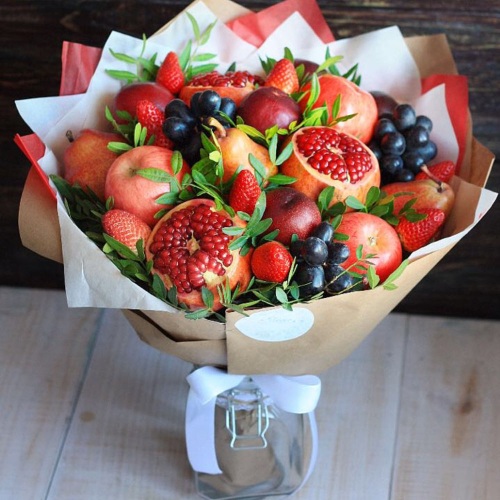
You will also need some fruit to serve as a base. It should be strong enough to hold the other components of the composition on top.
Basic fruits can be:
- apples;
- oranges;
- pineapples;
- grapefruit;
- mango.
Lighter fruits can be placed on top. These are the components that add extra color, texture, and dimension, but are not dense enough to support the weight of the other elements of the arrangement.
Fruits that can be placed on top and between the main ingredients include:
- small berries;
- strawberries;
- bananas;
- grape;
- kiwi.
When choosing bouquet components, it is recommended to pay special attention to the season. You can collect only summer or only citrus fruits. At this stage, it is recommended to be creative, especially if you need to save money.
Rules of composition
Packing a fruit bouquet is quite simple - first you need to lay out the fruits in the base container. You need to start by choosing the main components - these should be strong and durable fruits. They should be laid out on the bottom of the container, and the second layer - in the middle.
Then you need to place smaller and more fragile fruits on the edges. You should use the smallest components (for example, strawberries, grapes, etc.) to fill the gaps. It is important to make sure that all the elements of the composition are laid out securely and do not squeeze each other.
You don't have to limit your fruit bouquet to just fruit. There are plenty of other inexpensive additions that can be great gift items.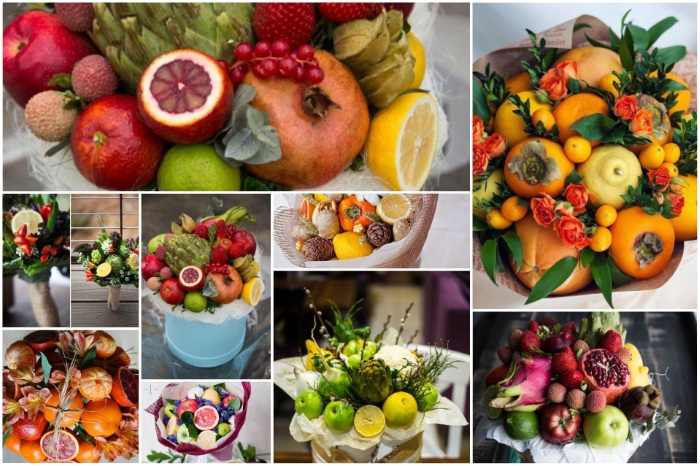
Some of the most successful options include:
- tea;
- coffee;
- wine or liqueur;
- breadsticks or pretzels;
- packaged cheese;
- candies;
- chocolate;
- nuts;
- decorative candles.
Since these bouquets are often given at various parties, it is recommended to use edible components that are best suited for such a setting. Anything that can be easily eaten will be a good addition.
When adding these elements to the bouquet, you may need to rearrange the fruit. Again, for stability, all larger items should be placed in the middle of the basket. Anything smaller can be placed in the spaces between them and along the edges.
Frame options
There are various ways to pack a fruit bouquet, depending on its contents and the frame used. Most often, the composition is placed in baskets, glass jars, bowls, boxes or low vases. For beginners, it is easiest to use a spacious wicker basket. It is necessary that the components are securely fastened in place, and the base is filled with floral foam or sponges.
Fruit frame
Another original idea for creating a composition is to use a large fruit as a frame. For example, it can be a watermelon or a melon. For autumn bouquets, it is appropriate to use a large pumpkin as a frame.
Wire frame
This is a very original way of forming a fruit bouquet. A homemade frame made of metal wire can support not too heavy fruits.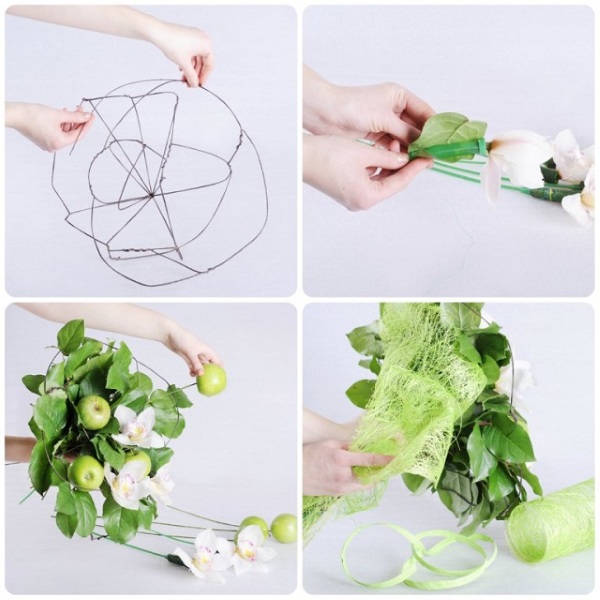
To create it you will need:
- PVC glue;
- knitting or embroidery thick colored threads;
- metal wire (a type that holds its shape well);
- corrugated paper in the same color as the threads;
- a bowl or pot with a wide mouth.
The creation process looks like this:
- You need to turn a flower pot or bowl upside down, cover it with plastic wrap and secure it with tape.
- Starting from the bottom, you should wrap the entire surface of the workpiece with colored threads, generously moistened with PVC glue, forming a continuous thick layer.
- From above, you need to wrap the workpiece several times with metal wire, starting from the bottom and moving upwards (you need to make 6-7 turns in total), creating a frame in the shape of the container used.
- The end of the wire must be pulled downwards, forming a handle.
- Another layer of glue-soaked thread should be wound on top to secure it to the wire.
- All wire must be covered with corrugated paper of the same color as the threads used.
- Once the glue has dried, the structure can be removed from the mold and filled with whatever you choose.
Decor options
You can pack a fruit bouquet in polyethylene film, as well as in wrapping or tissue paper. Ribbons and bows are usually added as decoration. However, you should not overuse decorations, since the fruits themselves look beautiful. The components of the bouquet can be decorated and placed in a very original way.
Strawberries in chocolate
A good decoration for a bouquet would be strawberries covered with a layer of chocolate.
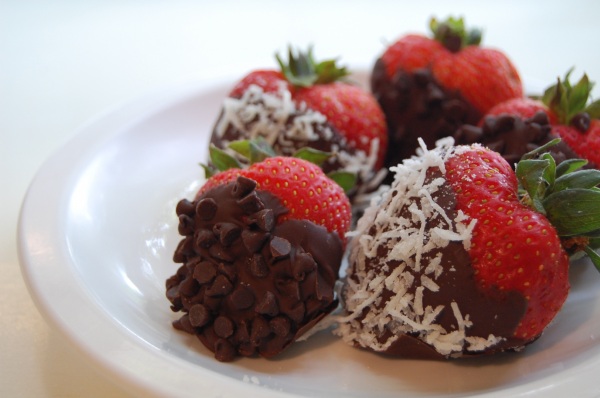
- It is necessary to thoroughly wash and dry large strawberries, put them in the refrigerator for 10 minutes.
- Chocolate (any type) must be grated or finely chopped and melted in a water bath or in a microwave.
- Thoroughly dry the berries, stick them on skewers from the stem side and dip them in the chocolate mass, shake them slightly and secure them in a vertical position (in a vase or on foam blocks), if desired, sprinkle them with multi-colored dragees or other edible decorations.
- Then you need to leave the berries until the coating has completely hardened.
Flowers from fruit pulp
You can create flower-shaped figures from pineapple, melon and some other fruits by cutting them into flat thick slices and cutting out pieces of the desired shape (either manually or using appropriate cookie cutters).
Decorative leaves and flowers
Artificial or natural leaves and flowers can act as a decorative element and at the same time as a support for a fruit composition. With their help, you can successfully hide skewers, floral foam and other fasteners.
For example, leafy vines, ivy or other similar plants can be wrapped around the edge of the base, and flowers with stems and leaves can be added into the spaces between large round fruits.
Into paper
A fruit bouquet consisting of a small number of elements can be packed in tissue or wrapping paper. To do this, you will need to string each fruit on a skewer, then gather them together and tape the free ends of the skewers.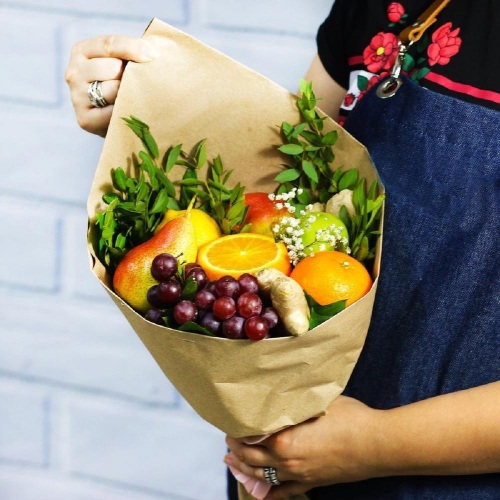
Then you need to wrap the composition with a large sheet of paper, placed diagonally, and tie it with a decorative ribbon.
In kraft paper
Large and heavy items can be packed using kraft paper. This packaging material is quite durable compared to other paper sheets. In addition, kraft paper is also available in colored form.
For example, you can put together a composition of citrus fruits combined with pieces of ginger and miniature jars of honey.
To do this you will need the following:
- It is necessary to attach each element to a wooden skewer (if necessary, to 2-3 skewers) using transparent tape.
- The free ends of the sticks should be secured with a large number of rubber bands. You can first connect individual groups of objects, and then secure the entire bouquet.
- Next, you need to securely tie the structure with transparent tape (in several layers).
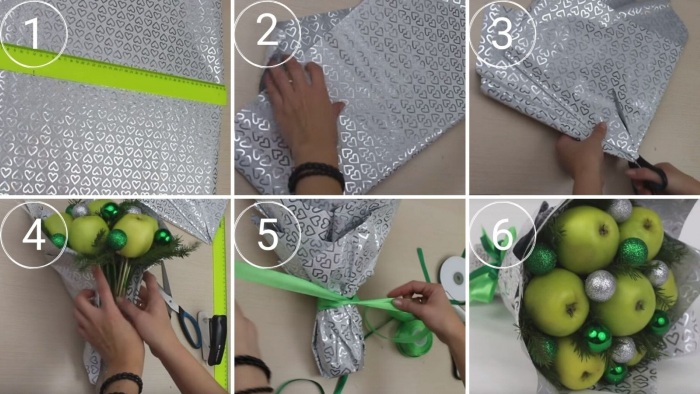
- Then you need to wrap the bouquet in craft paper and fasten its edges with hot glue. If it does not have a decorative coating, you can attach brightly colored corrugated paper sheets on top of it.
Into the film
If the composition uses cut fruits, it is advisable to wrap it in film.
To create such a bouquet you will need:
- half a watermelon or pumpkin with the pulp cut out, or a flower vase, planter or basket;
- floral foam;
- bamboo skewers and toothpicks;
- metal flower shaped cookie cutters;
- aluminum foil and polyethylene film.
Most fruits are suitable for creating an edible arrangement, but some may be more suitable due to color variation, size, and texture.
These include:
- pineapple;
- melon;
- strawberry;
- large blueberries and blackberries;
- seedless grapes;
- a bunch of large leafy greens.
The creation of a bouquet is carried out as follows:
- It is necessary to wash and dry all the ingredients, separate the grapes from the branches, and separate the greens into separate leaves.
- Pineapple and melon should be cut into slices and cut out into various flower shapes.
- Then you need to tightly fill the selected base with floral foam, cutting it out to fit the shape of the container if necessary.
- Next, you need to cover the foam with a layer of foil, tucking its edges inward, and spread out a continuous layer of green leaves.
- Fruit figures and strawberries should be strung on skewers, berries - on toothpicks (several pieces, alternating them). Marshmallows and shaped marmalade can be used as additional components.
- Then you need to stick all the blanks into the floral foam, adjusting the length of the skewers to create different heights of the “flowers”.
- All open areas remaining after placing the components should be covered with greenery.
- The assembled composition should be wrapped in decorative polyethylene film, its ends should be stapled and decorated with ribbons and/or bows, and stored in the refrigerator until presentation.
How to pack in a box
Placing a fruit bouquet in a box is the easiest way to design a composition. For this you will need floral foam or polystyrene foam, as well as bamboo skewers of different lengths.
The packaging process looks like this:
- The box must be filled with floral foam or pieces of polystyrene foam, and this material must be tightly packed or glued.
- Bamboo skewers need to be cut to different lengths, as the bouquet elements need to be placed at different heights.
- It is best to place the shortest "flowers" at the edges and then arrange them as they increase in height, moving towards the center.
- The skewers need to be pressed deep into the foam so that they stand straight and do not collide with each other.
Packaging options can be added
The simplest option for packing a fruit bouquet is a wide wicker basket. When using whole fruits, you won’t even need skewers – just tightly lay the elements on a thick layer of greenery or wrapping paper.
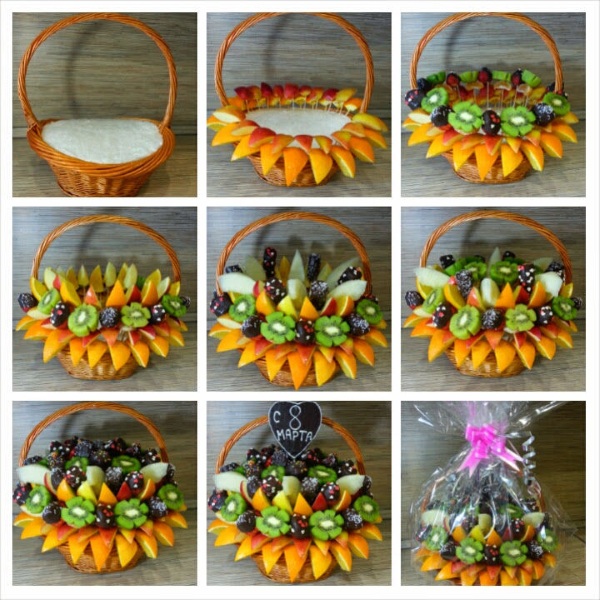
A fruit bouquet can be packed in a more original way. To do this, you will need a sheet of foam plastic, from which you can cut out any figure - a circle, a heart, and so on. In the middle, you need to make a hole of sufficient diameter so that the free ends of the skewers from the "flowers" can pass through it, fastened with tape. The lower part of the composition should be covered with decorative paper.
Video about making a fruit bouquet
The main mistakes beginners make when creating a fruit bouquet:
